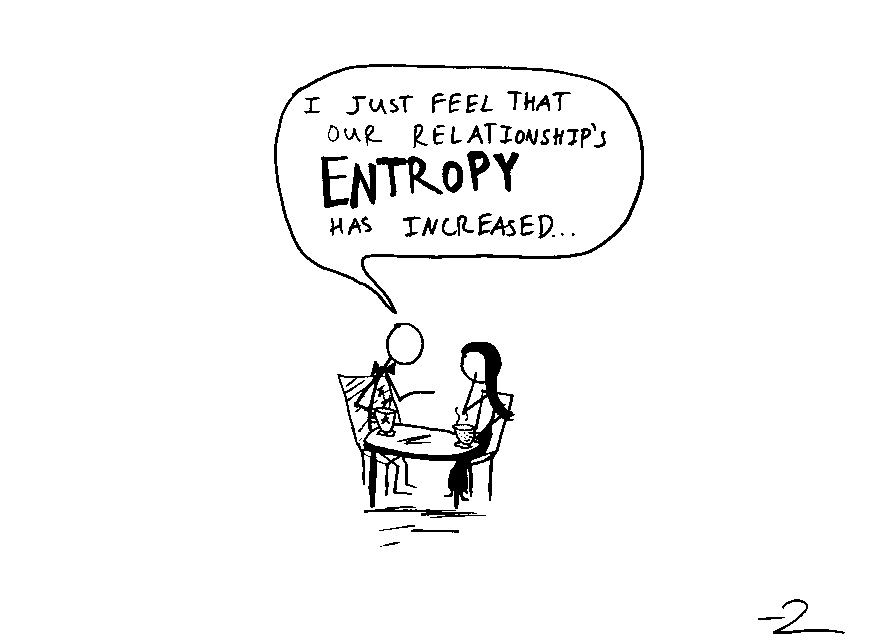This post has been cross posted with permission from Science and Salsa: The Salsa of Life by Andrés Flórez
This was one of my first notes and I would like to share it with you. The basic idea was to show how love can be interpreted in terms of energy consumption and how these can affect relationships.
One of the main arguments against studying love and relationships more quantitatively is that emotions and human feelings are always assumed to be very complex and impossible to describe by current sophisticated scientific methods. Phrases like “Love is so incomprehensible, that is better to silence the mind and let everything flows and don’t make any questions at all”, are very frequent among people. It could be that this is true, but aren’t you dear reader, a little curious, of what are the reasons for breaking up or being together in the first place?. In my opinion, there is a lot of help that science can give to elucidate the mechanisms of love dynamics, especially why people break up. A lot of work has been done in the past, especially by the famous psychologist John Gottman (Who has an institute about relationships), and published a very interesting book called “The Mathematics of Marriage”. The book is interesting in the sense that he was able to collect data and predict if a couple was going to divorce or not with very high accuracy. The mathematical models are actually not very complicated, but this tells you that something can be done to make our lives more pleasant by involving the reason in how we choose our partners.
 Without doing too much math, one could easily thing about a fundamental principle every relationship should have, “the minimum energy”. This comes from the second law of thermodynamics. As a simple example, in the case of proteins in the cell, they need to be folded correctly in order to perform the correct function. This folding could be spontaneous or sometimes helped by other proteins. However, “in order to be stable, the conformation has to have the lowest energy possible”. This is a very critical point to discuss about relationships. The stability in a relationships, meaning, the possibility to stay together for long periods of time, depends mostly on the energy expended in the relationship. I will give real life example to illustrate my point:
Without doing too much math, one could easily thing about a fundamental principle every relationship should have, “the minimum energy”. This comes from the second law of thermodynamics. As a simple example, in the case of proteins in the cell, they need to be folded correctly in order to perform the correct function. This folding could be spontaneous or sometimes helped by other proteins. However, “in order to be stable, the conformation has to have the lowest energy possible”. This is a very critical point to discuss about relationships. The stability in a relationships, meaning, the possibility to stay together for long periods of time, depends mostly on the energy expended in the relationship. I will give real life example to illustrate my point:
Normally when a man is dating a girl, it is clear that he has to expend a lot of energy, and by energy I mean the time, gifts, attention and so on, that the guy expends on the girl to capture her attention. (some girls need a lot of energy J), this is reasonable and it is what should be done, however this only happens at the beginning of the relationship most of the times. (I guess most of the girls get disappointed about this). However this initial energy has to be reduced, in the sense that the attraction becomes more rational and less emotional. Evolutionary speaking, this has to be done in this way, otherwise we would be sick by the dopamine effects or in thermodynamic words, we become unstable because of the excess of energy. In addition, once the relationship is started, the individual energy becomes into the energy of the couple. This does not change the principle at all — coming back to the example of the proteins — when two or more proteins interact, they should keep the interaction energy low to have a stable interaction (stable relationship in the case of the couple). So the question is now, what is this couple energy? When we think about it, most of the couple energy is normally expended in fights, and those fights whatever the reason is, it always comes from the fact that the couple has a lot of interaction energy that is not favorable, and here it comes the secret, the energy is high in fights because one thing is missing… the affinity!!!
The affinity basically indicates, what people normally call “Chemistry” or the “Spark”. This chemistry pretty much depends on the compatibility, like having similar likes, similar hobbies, similar ways of thinking, the more affinity the lowest energy and therefore more stability. It sounds tricky, but it is a fundamental principle. Sometimes we think love can manage everything, which for some exceptional cases it can, but there must be affinity in order to be stable. According to recent studies, one of the most common cases of divorce is actually not because of cheating, it is because the couple got bored. And getting bored is just a consequence that the couple is not enjoying or not trying exciting things together, like for example go for tango dancing, jump from a helicopter, learn Chinese, things like that. And maybe this boring behavior was a consequence of not having high affinity from the beginning.
Love chemistry is not a mystery, it works in the same way as real chemistry. If you have a strong chemistry with someone, you will have a high chance to maintain low energy and in this way you will have a stable and exciting relationship… sounds easy!!!
However this low energy status is not easy to get and depends also in some other little things besides affinity. You could love with passion, which is good and desirable, but when your brain is investing high levels of energy trying to solve problems that don’t depend on you, then it becomes a problem. For instance, if your girlfriend/boyfriend didn’t call you when you said, you could start imaging several things and generate a “movie” in your head, and those imaginations need a lot of glucose from your brain, and suppose you’re wasting 400 kilojoules thinking about something that is not true, you could win a Nobel prize investing that energy in research (some people will argue that you also need luck). But it is not peopleâs fault, the idea as it is concluded from the previous arguments, is to look for the right person that makes you feel good, as everybody want, with the condition to keep low energy status in order to have a successful relationship, this can only be achieved if you have a strong affinity with that person.
Andrés F.
